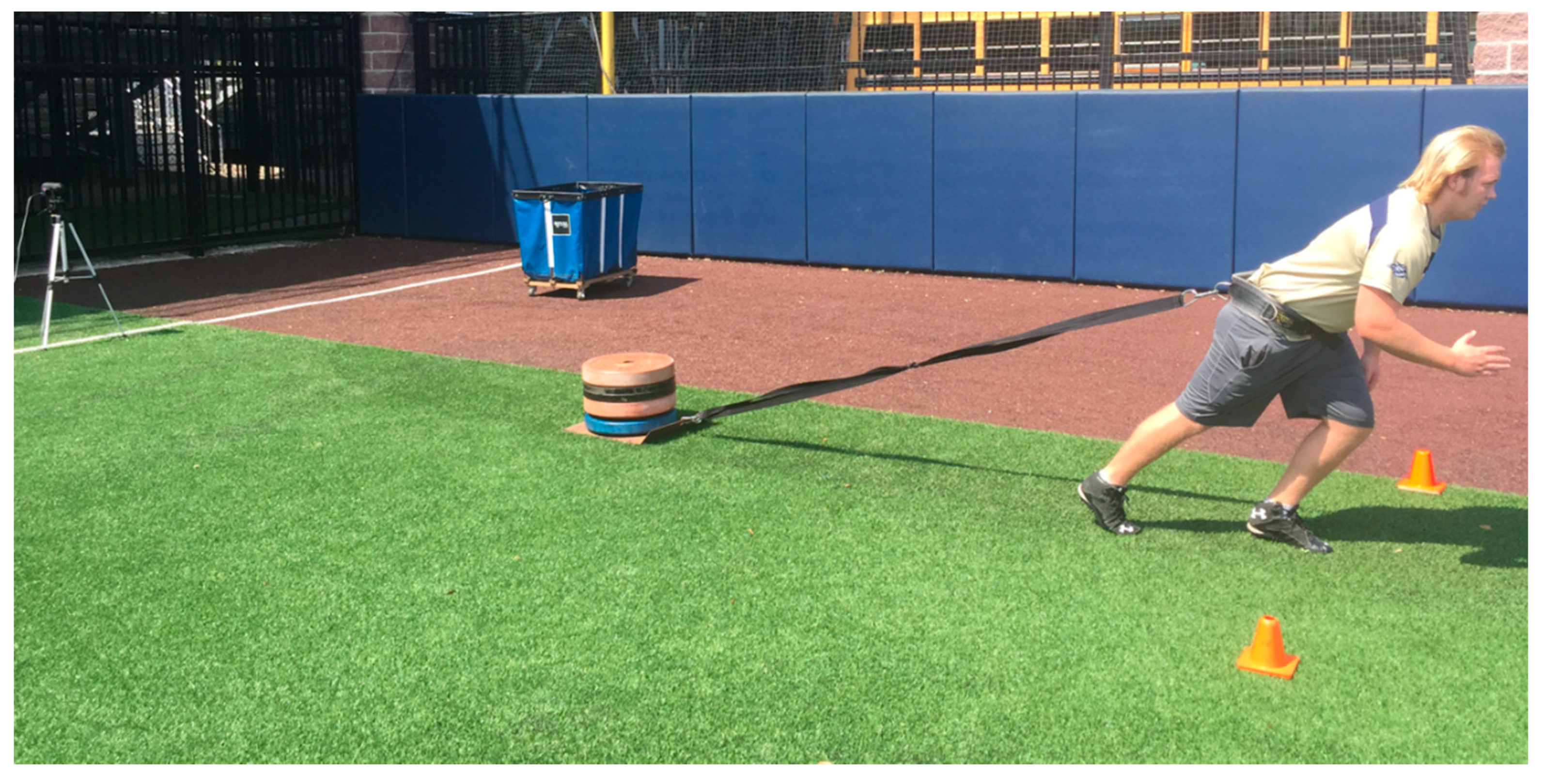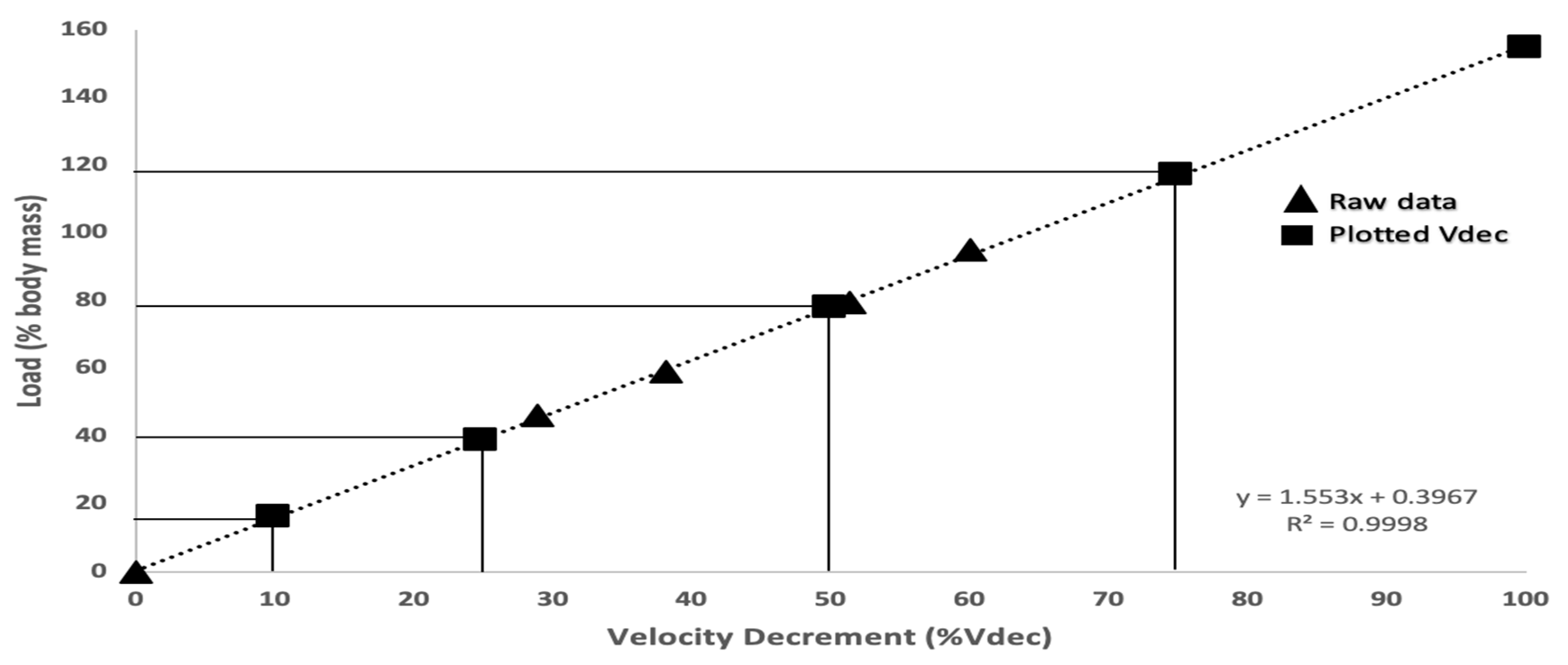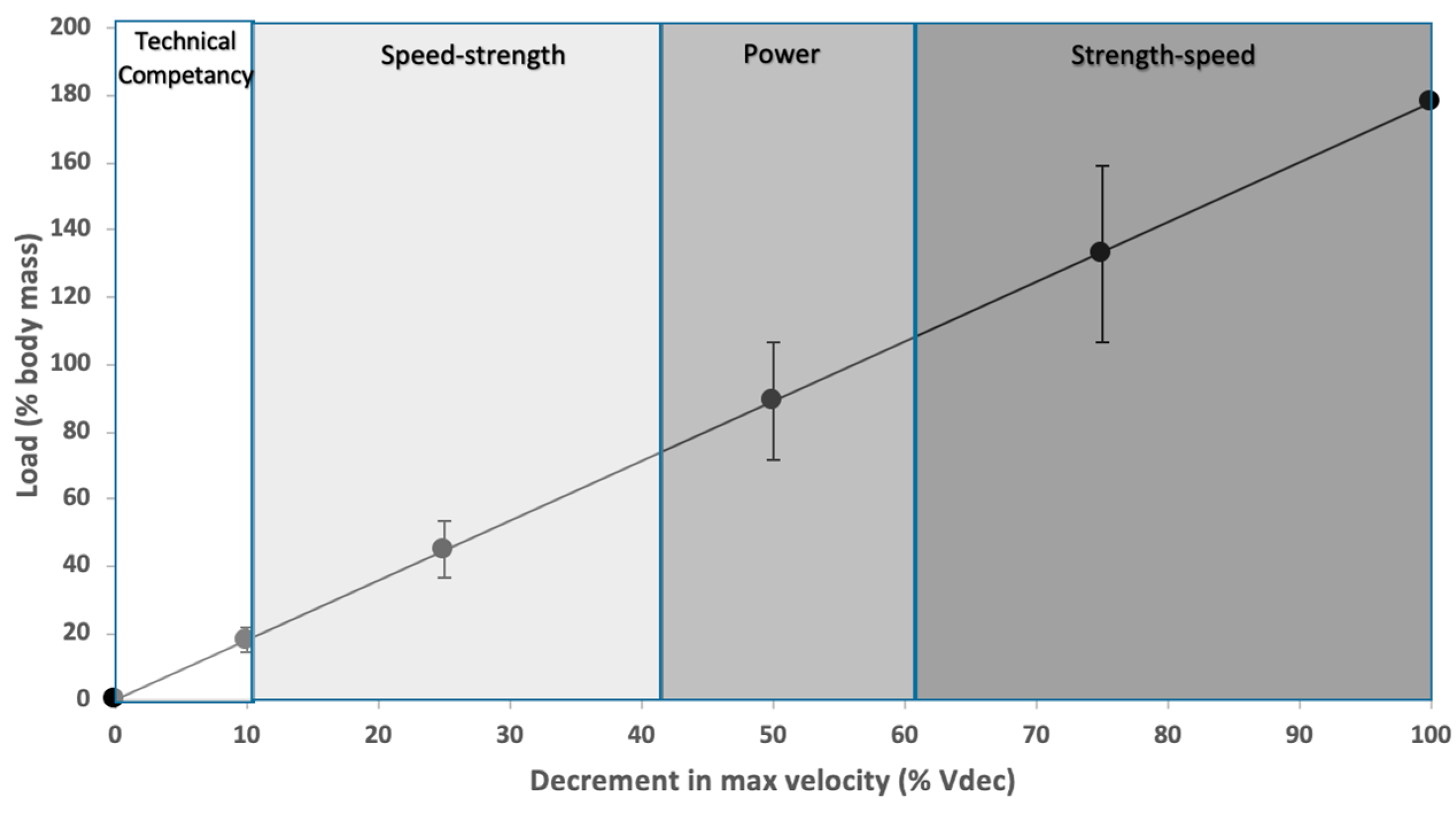Sled-Pull Load–Velocity Profiling and Implications for Sprint Training Prescription in Young Male Athletes
Abstract
1. Introduction
2. Materials and Methods
2.1. Subjects
2.2. Study Design
2.3. Procedures
2.3.1. Un-Resisted Sprinting Protocol
2.3.2. Resisted Sled-Pulling Protocol
2.4. Load–Velocity Relationship and Load Optimization
2.5. Statistical Analysis
3. Results
Load–Velocity Profiling Results
4. Discussion
5. Conclusions
Author Contributions
Funding
Conflicts of Interest
References
- Keiner, M.; Sander, A.; Wirth, K.; Hartmann, H.; Yaghobi, D. Correlations between Maximal Strength Tests at Different Squat Depths and Sprint Performance in Adolescent Soccer Players. Am. J. Sports Sci. 2014, 2, 1–7. [Google Scholar]
- Lockie, R.G.; Jalilvand, F.; Callaghan, S.J.; Jeffriess, M.D.; Murphy, A.J. Interaction Between Leg Muscle Performance and Sprint Acceleration Kinematics. J. Hum. Kinet. 2015, 49, 65–74. [Google Scholar] [CrossRef] [PubMed]
- Cronin, J.B.; Hansen, K.T. Strength and power predictors of sports speed. J. Strength Cond. Res. 2005, 19, 349–357. [Google Scholar]
- Rumpf, M.C.; Lockie, R.G.; Cronin, J.B.; Jalilvand, F. Effect of Different Sprint Training Methods on Sprint Performance Over Various Distances: A Brief Review. J. Strength Cond. Res. 2016, 30, 1767–1785. [Google Scholar] [CrossRef] [PubMed]
- Petrakos, G.; Tynan, N.C.; Vallely-Farrell, A.M.; Kiely, C.; Boudhar, A.; Egan, B. Reliability of the maximal resisted sprint load test and relationships with performance measures and anthropometric profile in female field sport athletes. J. Strength Cond. Res. 2017. [Google Scholar] [CrossRef]
- Alcaraz, P.E.; Carlos-Vivas, J.; Oponjuru, B.O.; Martinez-Rodriguez, A. The Effectiveness of Resisted Sled Training (RST) for Sprint Performance: A Systematic Review and Meta-analysis. Sports Med. 2018, 48, 2143–2165. [Google Scholar] [CrossRef]
- Alcaraz, P.E.; Palao, J.M.; Elvira, J.L. Determining the optimal load for resisted sprint training with sled towing. J. Strength Cond. Res. 2009, 23, 480–485. [Google Scholar] [CrossRef]
- Lockie, R.G.; Murphy, A.J.; Spinks, C.D. Effects of Resisted Sled Towing on Sprint Kinematics in Field-Sport Athletes. J. Strength Cond. Res. 2003, 17, 760–767. [Google Scholar]
- Cross, M.R.; Samozino, P.; Brown, S.R.; Morin, J.B. A comparison between the force-velocity relationships of unloaded and sled-resisted sprinting: single vs. multiple trial methods. Eur. J. Appl. Physiol. 2018, 118, 563–571. [Google Scholar] [CrossRef] [PubMed]
- Pantoja, P.D.; Carvalho, A.R.; Ribas, L.R.; Peyre-Tartaruga, L.A. Effect of weighted sled towing on sprinting effectiveness, power and force-velocity relationship. PLoS ONE 2018, 13, e0204473. [Google Scholar] [CrossRef]
- Morin, J.B.; Petrakos, G.; Jimenez-Reyes, P.; Brown, S.R.; Samozino, P.; Cross, M.R. Very-Heavy Sled Training for Improving Horizontal-Force Output in Soccer Players. Int. J. Sports Physiol. Perform. 2017, 12, 840–844. [Google Scholar] [CrossRef] [PubMed]
- Petrakos, G.; Morin, J.B.; Egan, B. Resisted sled sprint training to improve sprint performances: A systematic review. Sports Med. 2016, 46, 381–400. [Google Scholar] [CrossRef]
- Cahill, M.; Cronin, J.B.; Oliver, J.L.; Clark, K.; Cross, M.R.; Lloyd, R.S. Sled pushing and pulling to enhance speed capability. Strength & Cond. J. 2019. [Google Scholar] [CrossRef]
- Rumpf, M.C.; Cronin, J.B.; Mohamad, I.N.; Mohamad, S.; Oliver, J.L.; Hughes, M.G. The effect of resisted sprint training on maximum sprint kinetics and kinematics in youth. Eur. J. Sport Sci. 2015, 15, 374–381. [Google Scholar] [CrossRef]
- Rumpf, M.C.; Cronin, J.B.; Mohamed, I.N.; Oliver, J.O.; Hughes, M. Acute effects of sled towing on sprint time in male youth of different maturity status. Pediatric Exerc. Sci. 2014, 26, 71–75. [Google Scholar] [CrossRef] [PubMed]
- Cross, M.R.; Brughelli, M.; Samozino, P.; Brown, S.R.; Morin, J.B. Optimal Loading for Maximizing Power During Sled-Resisted Sprinting. Int. J. Sports Physiol. Perform. 2017, 12, 1069–1077. [Google Scholar] [CrossRef] [PubMed]
- Meyers, R.W.; Oliver, J.L.; Hughes, M.G.; Cronin, J.B.; Lloyd, R.S. Maximal sprint speed in boys of increasing maturity. Pediatric Exerc. Sci. 2015, 27, 85–94. [Google Scholar] [CrossRef]
- Moran, J.; Sandercock, G.; Rumpf, M.C.; Parry, D.A. Variation in Responses to Sprint Training in Male Youth Athletes: A Meta-analysis. Int. J. Sports Med. 2017, 38, 1–11. [Google Scholar] [CrossRef]
- Mirwald, R.L.; Baxter-Jones, A.D.G.; Bailey, D.A.; Beunene, G.P. An assessment of maturity from anthropometric measures. Med. & Sci. Sports & Exerc. 2002, 34, 689–694. [Google Scholar]
- Simperingham, K.D.; Cronin, J.B.; Ross, A. Advances in Sprint Acceleration Profiling for Field-Based Team-Sport Athletes: Utility, Reliability, Validity and Limitations. Sports Med. 2016, 46, 1619–1645. [Google Scholar] [CrossRef]
- Hopkins, W.G. Spreadsheets for analysis of validity and reliability. Sportscience 2017, 21, 36–44. [Google Scholar]
- Meylan, C.M.P.; Cronin, J.B.; Oliver, J.L.; Hopkins, W.G.; Pinder, S. Contribution of vertical strength and power to sprint performance in young male athletes. Int. J. Sports Med. 2014, 35, 749–754. [Google Scholar] [PubMed]
- Cottle, C.A.; Carlson, L.A.; Lawrence, M.A. Effects of sled towing on sprint starts. J. Strength Cond. Res. 2014, 28, 1241–1245. [Google Scholar] [CrossRef] [PubMed]
- Harrison, A.J.; Bourke, G. The Effect of Resisted Sprint Training on Speed and Strength Performance in Male Rugby Players. J. Strength Cond. Res. 2009, 23, 275–283. [Google Scholar] [CrossRef]
- Cross, M.R.; Lahti, J.; Brown, S.R.; Chedati, M.; Jimenez-Reyes, P.; Samozino, P.; Eriksrud, O.; Morin, J.B. Training at maximal power in resisted sprinting: Optimal load determination methodology and pilot results in team sport athletes. PLoS ONE 2018, 13, e0195477. [Google Scholar] [CrossRef]
- Viru, A.; Loko, J.; Harro, M.; Volver, A.; Laaneots, L.; Viru, M. Critical periods in the development of performance capacity during childhood and adolescence. Eur. J. Phys. Educ. 1999, 4, 75–119. [Google Scholar] [CrossRef]
- Papaikovou, G.; Giannakos, A.; Michailidis, C.; Patikas, D.; Bassa, E.; Kalopisis, V.; Anthrakidis, N.; Kotzamanidis, C. The effect of chronological age and gender on the development of sprint performance during childhood and puberty. J. Strength Cond. Res. 2009, 23, 2568–2573. [Google Scholar] [CrossRef] [PubMed]
- Lesinski, M.; Prieske, O.; Granacher, U. Effects and dose-response relationships of resistance training on physical performance in youth athletes: A systematic review and meta-analysis. Br. J. Sports Med. 2016, 50, 781–795. [Google Scholar] [CrossRef]
- Martinez-Valencia, M.A.; Romero-Arenas, S.; Elvira, J.L.; Gonzalez-Rave, J.M.; Navarro-Valdivielso, F.; Alcaraz, P.E. Effects of Sled Towing on Peak Force, the Rate of Force Development and Sprint Performance During the Acceleration Phase. J. Hum. Kinet. 2015, 46, 139–148. [Google Scholar] [CrossRef]



| Reliability of Sprint Variables | Mean | Change in Mean (%) | CV (%) | ICC | ||||||
|---|---|---|---|---|---|---|---|---|---|---|
| Trial 1 | Trial 2 | Trial 3 | Trial 1–2 | Trial 2–3 | Trial 1–2 | Trial 2–3 | Trial 1–2 | Trial 2–3 | ||
| Vmax (m/s) | Un-resisted | 7.9 ± 0.5 | 8.0 ± 0.4 | 7.9 ± 0.5 | 1.0 | −1.5 | 2.8 | 2.1 | 0.84 | 0.88 |
| (−1.1–3.1) | (−3.1–0.0) | (2.1–4.4) | (1.6–3.3) | (0.64–0.95) | (0.68–0.96) | |||||
| 27 kg | 6.1 ± 0.8 | 6.1 ± 0.8 | 6.1 ± 0.7 | −0.6 | −0.7 | 4.9 | 3.1 | 0.84 | 0.92 | |
| (−4.1–3.0) | (−1.7–3.2) | (3.6–7.6) | (2.3–5.0) | (0.60–0.94) | (0.79–0.97) | |||||
| +20% BM | 5.2 ± 0.5 | 5.2 ± 0.5 | 5.1 ± 0.6 | −1.1 | −1.0 | 3.4 | 4.2 | 0.91 | 0.87 | |
| (−3.5–1.4) | (−4.1–2.3) | (2.5–5.2) | (3.1–6.7) | (0.75–0.97) | (0.66–0.95) | |||||
| +40% BM | 4.4 ± 0.6 | 4.1 ± 0.4 | 4.4± 0.6 | −5.7 | 6.2 | 7.1 | 6.7 | 0.72 | 0.77 | |
| (−10.5–−0.7) | (1.2–11.5) | (5.2–11.3) | (4.9–10.5) | (0.36–0.89) | (0.45–0.91) | |||||
| +60% BM | 3.7 ± 0.6 | 3.5 ± 0.5 | 3.8 ± 0.6 | −7.1 | 8.0 | 8.6 | 9.0 | 0.69 | 0.73 | |
| (−13.4–−0.4) | (0.7–15.8) | (6.1–14.6) | (6.4–14.8) | (0.24–0.90) | (0.34–0.90) | |||||
| Lopt (% BM) | 10% Vdec | 17 ± 1 | 17 ± 1 | 17 ± 1 | −1.5 | 0.1 | 3.2 | 3.3 | 0.71 | 0.65 |
| (−4.3–1.4) | (−2.8–3.0) | (2.3–5.6) | (2.3–5.6) | (0.26–0.91) | (0.15–0.88) | |||||
| 25% Vdec | 42 ± 4 | 43 ± 3 | 42 ± 2 | 1.2 | −0.7 | 4.8 | 3.7 | 0.60 | 0.60 | |
| (−3.0–5.6) | (−3.9–2.6) | (3.4–8.3) | (2.6–6.4) | (0.07–0.87) | (0.08–0.87) | |||||
| 50% Vdec | 84 ± 7 | 85 ± 5 | 85 ± 4 | 1.3 | −0.6 | 4.6 | 3.5 | 0.63 | 0.64 | |
| (−2.7–5.5) | (−3.7–2.5) | (3.3–8.0) | (2.5–6.1) | (0.12–0.88) | (0.13–0.88) | |||||
| 75% Vdec | 125 ± 11 | 128 ± 8 | 127 ± 5 | 1.4 | −0.9 | 4.8 | 3.7 | 0.60 | 0.60 | |
| (−2.8–5.8) | (−4.1–2.4) | (3.4–8.3) | (2.6–6.4) | (0.07–0.87) | (0.07–0.87) | |||||
| Slope Load–Velocity | −1.72 ± 0.15 | −1.72 ± 0.08 | −1.72 ± 0.06 | −0.7 | 0.4 | 4.0 | 2.2 | 0.71 | 0.75 | |
| (−4.1–2.9) | (−1.5–2.4) | (2.8–6.8) | (1.6–3.8) | (0.23–0.91) | (0.30–0.92) | |||||
© 2019 by the authors. Licensee MDPI, Basel, Switzerland. This article is an open access article distributed under the terms and conditions of the Creative Commons Attribution (CC BY) license (http://creativecommons.org/licenses/by/4.0/).
Share and Cite
Cahill, M.J.; Oliver, J.L.; Cronin, J.B.; Clark, K.P.; Cross, M.R.; Lloyd, R.S. Sled-Pull Load–Velocity Profiling and Implications for Sprint Training Prescription in Young Male Athletes. Sports 2019, 7, 119. https://doi.org/10.3390/sports7050119
Cahill MJ, Oliver JL, Cronin JB, Clark KP, Cross MR, Lloyd RS. Sled-Pull Load–Velocity Profiling and Implications for Sprint Training Prescription in Young Male Athletes. Sports. 2019; 7(5):119. https://doi.org/10.3390/sports7050119
Chicago/Turabian StyleCahill, Micheál J., Jon L. Oliver, John B. Cronin, Kenneth P. Clark, Matt R. Cross, and Rhodri S. Lloyd. 2019. "Sled-Pull Load–Velocity Profiling and Implications for Sprint Training Prescription in Young Male Athletes" Sports 7, no. 5: 119. https://doi.org/10.3390/sports7050119
APA StyleCahill, M. J., Oliver, J. L., Cronin, J. B., Clark, K. P., Cross, M. R., & Lloyd, R. S. (2019). Sled-Pull Load–Velocity Profiling and Implications for Sprint Training Prescription in Young Male Athletes. Sports, 7(5), 119. https://doi.org/10.3390/sports7050119






